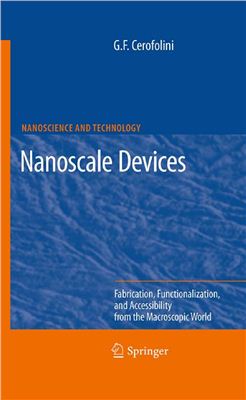The series NanoScience and Technology. Springer, 2009. 210 p. ISBN
978-3-540-92731-0
This book is written in that spirit: I intend to show that circuits formed by a planar arrangement of nanoscopic devices with density of the order of 10^11 cm^-2 can in principle be prepared via the combination of existing architectures, materials, and techniques. Whether or not that combination may indeed become a technology for nanoelectronics is essentially related to the effort spent in the solution of detailed problems that certainly will arise in such an attempt.
Although the temporal constraint does not apply to other devices (like sensors or electromechanical systems), their practical implementation would be greatly simplified if they too were based on some conservative extension of the current technology.
Although the topics considered in this book are highly technical, I have tried to maintain unity of style, privileging logical connections with respect to detailed information. Because of its formative, rather than informative character, this book (or at least its first part) might be used for courses on Nanoscience or Nanotechnology. A possible use of this book as a textbook is sketched in Fig. 0.1, where the backbone sketches the main body of the course, whereas the sides show possible additional topics.
The core of this book is based on two review articles: Molecular electronics in silico, Appl. Phys. A 91, 181 (2008), with E. Romano; and Multispacer patteing: a technology for the nano era, to appear in Handbook of Nanophysics, edited by K. Sattler for Taylor & Francis (to be published), with E. Romano and P. Amato. In tu, they had origin from a series of lectures prepared for the 2007 and 2008 Summer Schools on Nanoelectronic Circuits at Tools held at the Ecole Polytechnique
Federale de Lausanne (Swiss).
List of Acronyms.
Part I. Basics.
1 Matter on the Nanoscale.
2 Top-Down Paradigm to Miniaturization.
3 Physical Limits to Miniaturization.
The Crossbar Structure.
Crossbar Production.
The Litho-to-Nano link.
Functional Molecules.
Grafting Functional Molecules.
Part II. Advanced Topics: Self-Similar Structures, Molecular Motors, and Nanobiosystems.
Examples.
Self-Similar Nanostructures.
Molecular Motors.
Nanobiosensing.
Abstract Technology.
References.
Index.
This book is written in that spirit: I intend to show that circuits formed by a planar arrangement of nanoscopic devices with density of the order of 10^11 cm^-2 can in principle be prepared via the combination of existing architectures, materials, and techniques. Whether or not that combination may indeed become a technology for nanoelectronics is essentially related to the effort spent in the solution of detailed problems that certainly will arise in such an attempt.
Although the temporal constraint does not apply to other devices (like sensors or electromechanical systems), their practical implementation would be greatly simplified if they too were based on some conservative extension of the current technology.
Although the topics considered in this book are highly technical, I have tried to maintain unity of style, privileging logical connections with respect to detailed information. Because of its formative, rather than informative character, this book (or at least its first part) might be used for courses on Nanoscience or Nanotechnology. A possible use of this book as a textbook is sketched in Fig. 0.1, where the backbone sketches the main body of the course, whereas the sides show possible additional topics.
The core of this book is based on two review articles: Molecular electronics in silico, Appl. Phys. A 91, 181 (2008), with E. Romano; and Multispacer patteing: a technology for the nano era, to appear in Handbook of Nanophysics, edited by K. Sattler for Taylor & Francis (to be published), with E. Romano and P. Amato. In tu, they had origin from a series of lectures prepared for the 2007 and 2008 Summer Schools on Nanoelectronic Circuits at Tools held at the Ecole Polytechnique
Federale de Lausanne (Swiss).
List of Acronyms.
Part I. Basics.
1 Matter on the Nanoscale.
2 Top-Down Paradigm to Miniaturization.
3 Physical Limits to Miniaturization.
The Crossbar Structure.
Crossbar Production.
The Litho-to-Nano link.
Functional Molecules.
Grafting Functional Molecules.
Part II. Advanced Topics: Self-Similar Structures, Molecular Motors, and Nanobiosystems.
Examples.
Self-Similar Nanostructures.
Molecular Motors.
Nanobiosensing.
Abstract Technology.
References.
Index.

